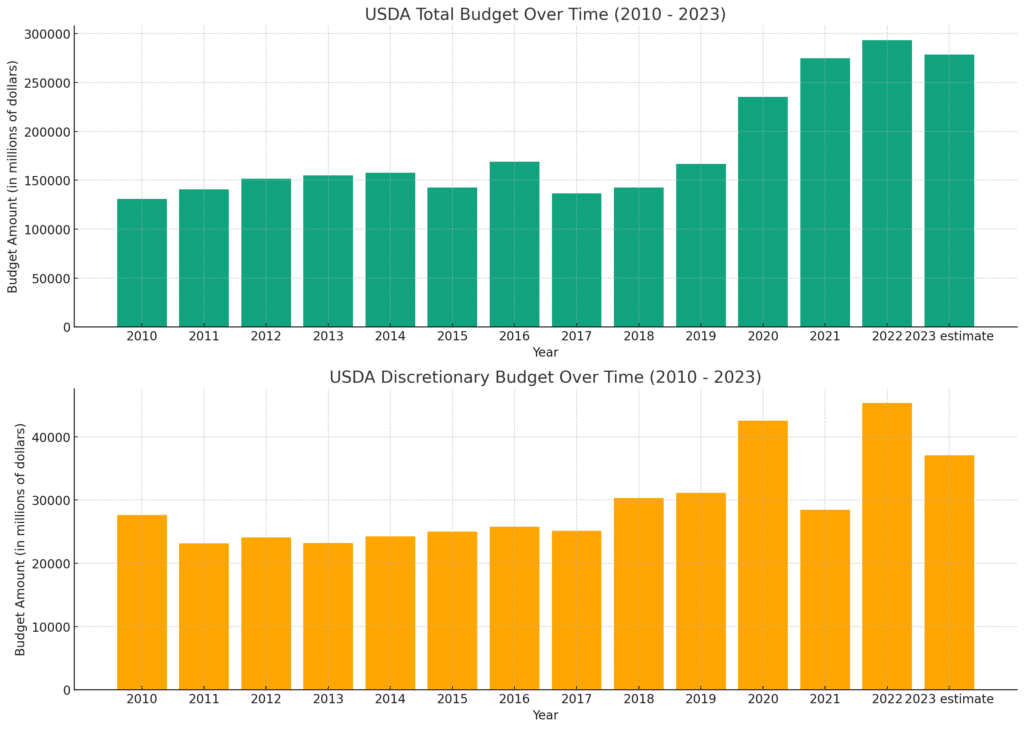Introduction – USDA Budget Cuts
The United States Department of Agriculture (USDA) manages a massive budget that significantly influences several areas directly touching our lives, from what you eat to how farm products are safely transported to your local grocery store, and the growth of rural communities. It’s crucial to understand what the USDA budget involves and the effects of budget cuts on various sectors.

Did The USDA Cut Its Budget?
Yes but its basically a return to prepandemic levels. The USDA’s discretionary budget, which includes grant funding, has decreased in recent years, the overall budget remains relatively high. The apparent cut is basically a return to pre-pandemic levels.
Take a look at our data analysis above of US government budget numbers. The total USDA budget, which includes both discretionary and mandatory spending, has generally increased over the years, with a significant surge observed between 2019 and 2021, likely in response to the COVID-19 pandemic.
However, the discretionary budget, which is the portion typically used for grants and other flexible spending, increased substantially during the same period but then declined in 2022 and 2023.
This decrease might give the impression of a budget cut, but it’s more accurately a return to pre-pandemic levels after an extraordinary period of increased spending.
So, while the discretionary budget, and hence potentially the availability of grant money, has indeed decreased in recent years, this should be viewed in the context of an unusually high level of spending during the pandemic.
USDA Budget Cuts
For individuals and organizations seeking grant funding, which falls under the discretionary component of the USDA budget, the analysis reveals notable fluctuations over the period from 2010 to 2023.
Initially, the discretionary budget experienced moderate variations, but a significant increase was observed between 2019 and 2021. This was likely in response to the COVID-19 pandemic, as additional funding was necessary to support agricultural industries and rural communities severely impacted by the crisis.
The trend, however, did not persist and a marked dip occurred in 2022 and 2023, suggesting a return to pre-pandemic budget levels. It is also worth noting that despite the decrease in the discretionary budget, the total USDA budget remained relatively high, indicating that a significant portion of funds was allocated to mandatory spending.
This understanding of budget trends is crucial for potential grant applicants as it provides insight into the availability of discretionary funds, which can influence the timing and success of grant applications.
The specific availability of grant funds can be influenced by many other factors, including policy changes and specific departmental priorities.
Grant Writers: Understand Discretionary Spend vs Mandatory Spend
Understanding the intricacies of the USDA budget also involves discerning the differences between discretionary and mandatory spending. Discretionary spending is the portion of the budget that the Congress appropriates on a yearly basis. It’s essentially ‘discretionary’ because the amounts can be adjusted annually based on the Congress’s preferences, societal needs, and available resources.
For instance, funding for rural development projects may fall under this category, as Congress could increase or decrease the amount based on their policy objectives or prevailing economic conditions. On the other hand, mandatory spending is largely driven by existing laws.
This spending automatically goes into programs that are legally obligated to receive funding, like farm subsidies or the Supplemental Nutrition Assistance Program (SNAP). While these amounts can change, they typically require legislative action to adjust the terms of the program itself.
Both these types of funding play an integral role in the functioning of the USDA and understanding them is crucial for those seeking grants or concerned about the impact of the budget on their activities.
Overview of USDA Budget
Yearly, the USDA allocates its financial resources across several areas, making key decisions that directly affect American lives.
Whether it’s ensuring food safety, fostering rural development, promoting agricultural activities, or driving nutritional programs, USDA’s decisions carry far-reaching impacts.
By examining the budget allocation for the current fiscal year and comparing it to previous ones, you can gain a perspective on the shifting priorities of this influential department.
USDA Budget Cuts
Budget decisions often involve difficult compromises. To adapt to fluctuating economic trends or shifting policy priorities, the USDA sometimes has to make cuts.
Understanding where these cuts have been made, and why, can provide valuable insight into the direction of the USDA’s work.
For instance, the agriculture sector could be more affected by these cuts, which can impact local farms and indirectly, your food basket.
Impact of USDA Budget Cuts
Deciphering the impacts of budget cuts on the sectors that the USDA serves is essential. It sheds light on the subsequent-aftermath in rural development, food safety, nutrition, and agriculture, setting a stage for long-term effects.
For example, budget cuts in the agricultural sector may lead to less funding for farm subsidies which, in turn, could affect the livelihood of farmers.
USDA Budget and Sustainability
Interestingly, the USDA budget also impacts our environment. It plays a vital part in the country’s carbon reduction efforts.
Reduced funding in sustainability programs could mean lesser prominence to eco-friendly initiatives, affecting our strides towards a sustainable future.
Policymaker Perspectives on USDA Budget Cuts
Through its budget decisions, the USDA often finds itself under the microscope of policymakers, each bringing their unique perspectives.
Digging into these debates, you will discover different viewpoints regarding the budget cuts’ necessity and justifiability and their proposed solutions for the challenges posed by these financial adjustments.
Our Recommendation For USDA Grant Applications – Apply For Your Grant!

The overall budget remains robust, indicating a strong commitment to the Department’s mission and programs. This is a positive signal for potential grant applicants, as it suggests that funding is available for initiatives aligned with USDA priorities.
Therefore, we strongly encourage grant writers to continue developing and submitting their proposals. Even if the discretionary budget has seen a decline, the commitment to funding impactful programs remains strong, and well-crafted, mission-aligned proposals have a meaningful chance of securing funding.
Conclusion
In essence, the USDA budget is a complex subject with consequences that ripple through various aspects of American society.
It’s a testament to the importance of governmental budget decisions and their direct effect on our daily lives.
By staying informed, you can contribute to discussions on these impacts and changes shaping our lives for the future.
References
As with all significant topics, studious readers are encouraged to further their understanding by checking the official USDA budget documents and other credible resources. These will provide accurate and in-depth knowledge of the USDA budget and its related concerns.
Data Analysis Methods
The data for this analysis was obtained from the Office of Management and Budget (OMB), specifically from tables 5.2 and 5.4, which provide detailed information on the total and discretionary budget of various U.S. government departments, respectively.
These tables were accessed in Excel format, loaded into Python using the pandas library, and cleaned to ensure a usable format for analysis. The data pertaining to the U.S. Department of Agriculture (USDA) was extracted for the years 2010 through 2023.
The total and discretionary budget figures for these years were then plotted separately using matplotlib to visualize the trends over time.
The analysis revealed that both the total and discretionary budgets for the USDA have experienced significant increases and subsequent declines during this period, although their patterns of change differed somewhat.
